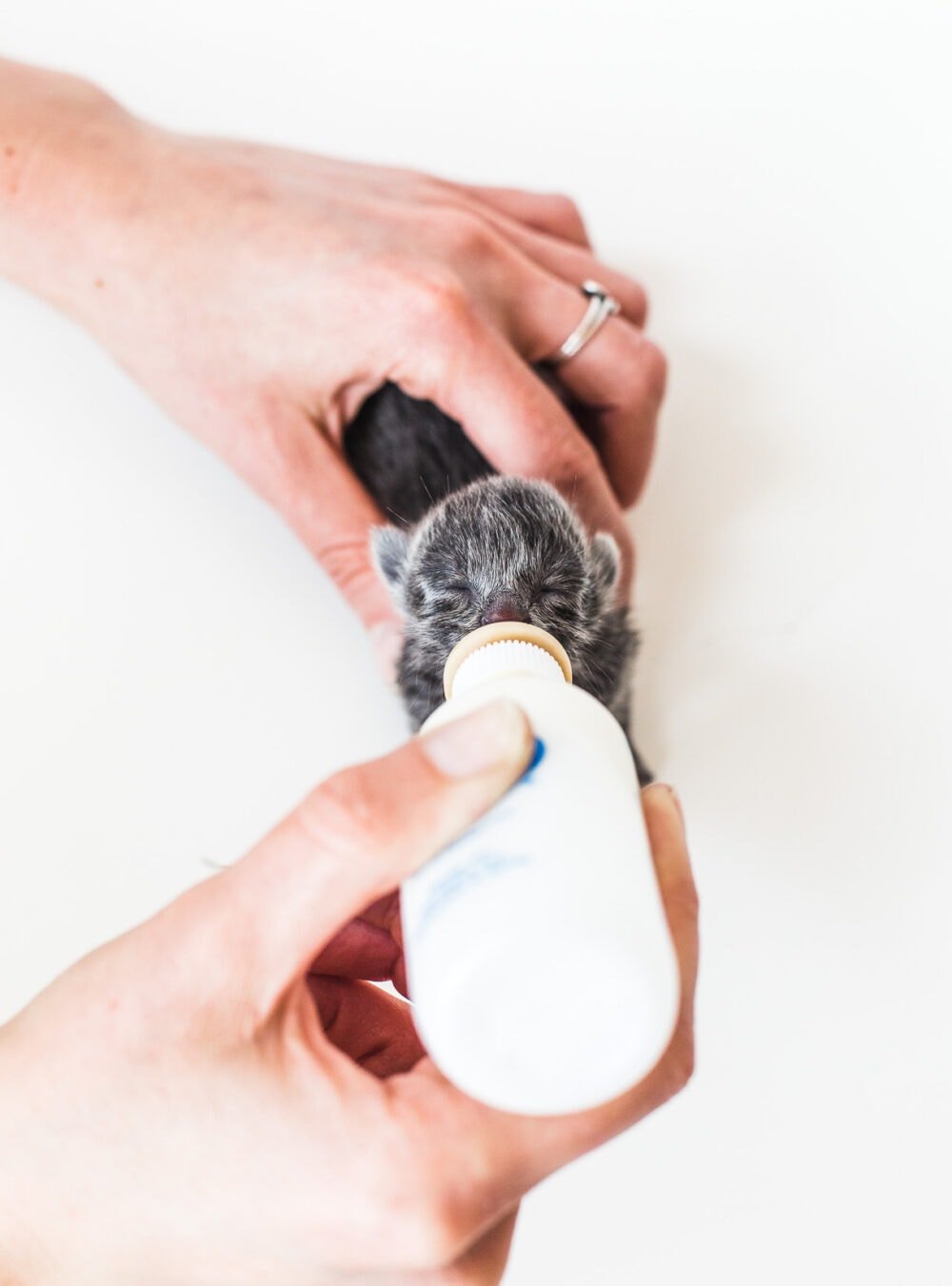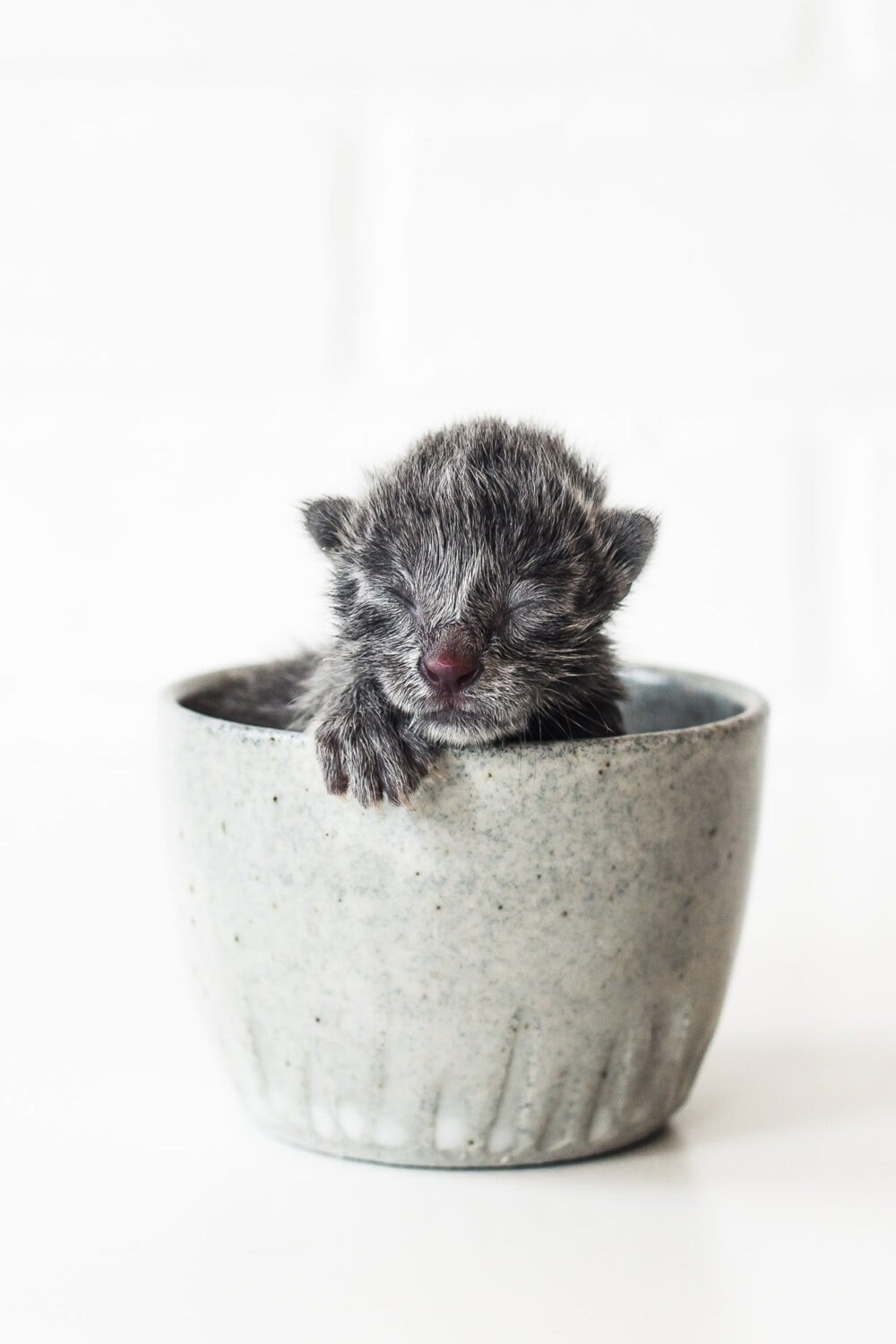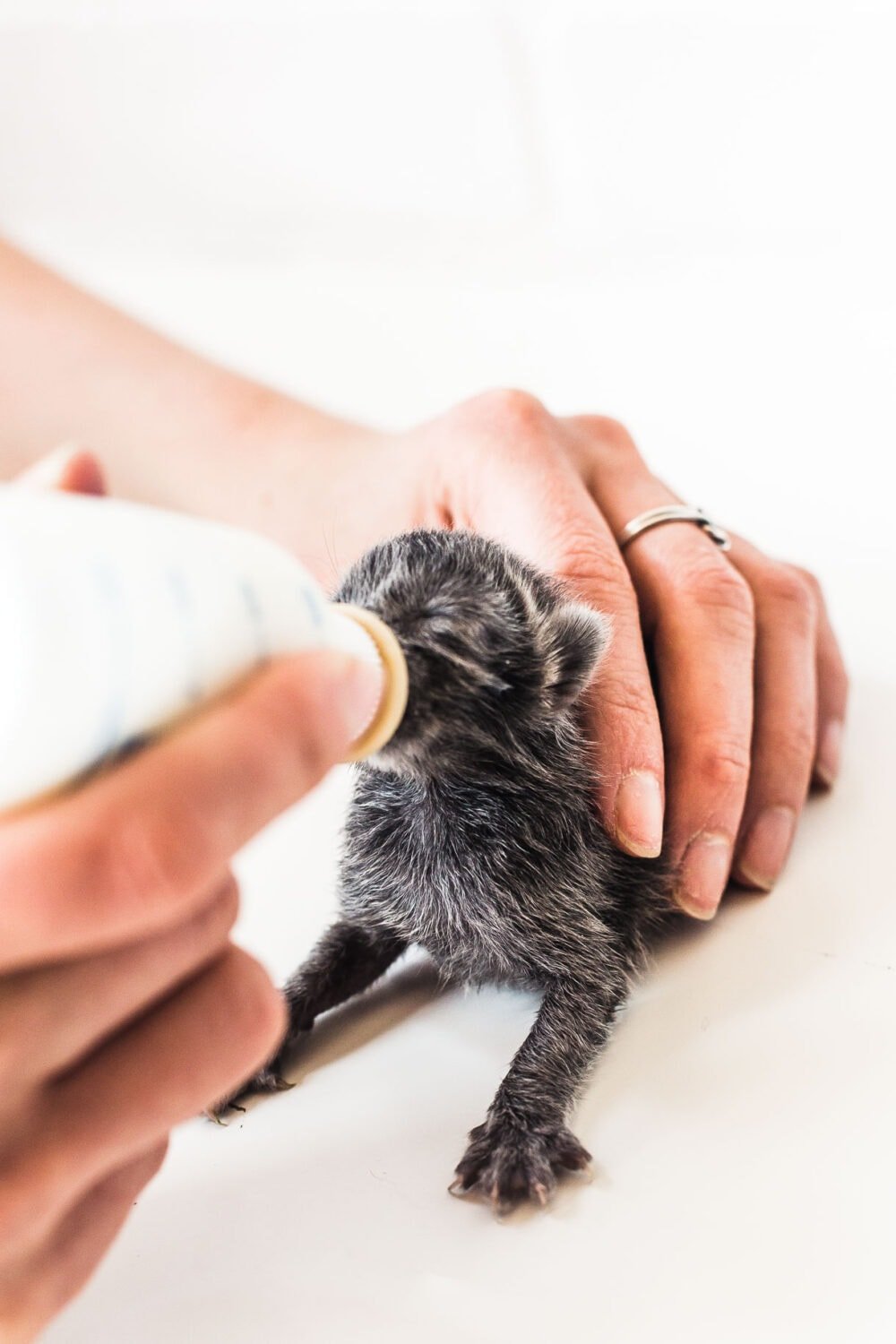Bottle Feeding Kittens: Everything You Need to Know
Since 2018, I’ve bottle fed and cared for over 50 kittens who are too young to eat on their own. Prior to that, I had one 8 year old cat of my own, but wanted many. ❤️ And I felt the need to volunteer in a capacity that aligned with one of my passions – cats!
So I began volunteer rescue work through Feline Rescue, and am now exclusively with Bitty Kitty Brigade in Minneapolis. Our mission is to save orphaned neonatal kittens who are often euthanized at shelters or animal control because they do not have the knowledge, experience, or time to bottle feed kittens. Over the years, I’ve raised orphaned bottle kittens as young as 1 day old, and have cared for them through adoption at 12 weeks. We’ve also adopted one of our fosters, our sweet Tuxedo girl we named Bleu. All that to say, I’ve learned and seen a lot in relation to bottle feeding kittens and am happy to share my experiences with you so you can successfully bottle feed too.
How to Bottle Feed Kittens:
The first thing you want to be sure of when you have kittens in your care is that they are warm, as they cannot regulate their own body temperatures. Keep a small heating pad wrapped a towel in their bed so that they stay warm, and are ready to eat. *Never attempt to feed a cold kitten. If their body temperature is less than 102 degrees F, place the kitten on an approved heating pad safely wrapped in two or three layers of towels. Turn the kitten side to side every 5 minutes. To stimulate blood flow, you may, ever so gently, massage the kitten with hand-rubbing.
- Begin by whisking KMR (kitten milk replacement) with water. You’ll use 1 part powdered formula to 2 parts water. Error on the side of a little more water, rather than formula, as you want to be sure they can digest it easily and prevent constipation.
- Warm the liquid mixture in the microwave for 10-15 seconds, until just above room temperature. If it’s too cold, the kittens will not want to eat it. And if it’s too hot, it can burn them.
- Wash your hands with soap and water before feeding them.
- Then fill a syringe (my preference) or bottle with the warm formula. And place a miracle nipple on the end. These nipples are constructed to release the proper flow of formula, so that the bottle babies do not swallow too much at one time, which can happen if you use a regular nipple that you’ve cut a hole in.
- Put the kitten on a small blanket, on his tummy similar the position he’d be if feeding on his mama. You can also swaddle them in an upright position if that is easier for you. But never feed a kitten on its back.
- Slowly guide the nipple into the kittens mouth, using your hands to stabilize his head, and push a few drops of formula out of your syringe into their mouth so they get a taste of it. Then wiggle the nipple slowly a bit so they are encouraged to latch and start suckling. Gently and slowly depress the syringe to let the milk come out, at an even flow. Do not force milk down their throat, allow them to go at their own pace. You also want to make sure that the kitten is not gasping for the milk, as it can travel into their lungs and cause aspiration pneumonia.
Video of Bottle Feeding Kittens

Supplies for Bottle Feeding Kittens
Miracle Nipples: This is the only type of nipple I use because it was developed with small animals in mind, like kittens, puppies, and rabbits. The Miracle Nipple was designed by a wildlife rehabilitator with years of experience feeding orphaned animals, and it’s foolproof. It also alleviates the chance of an animal swallowing the entire nipple and with proper use will prevent aspiration of formula.
Miracle Syringes: I find it to be much easier to control the flow of formula using a Miracle syringe and depressing it slowly as the kittens eat, rather than having to figure out the right pressure for squeezing a bottle. These syringes also don’t stick after a few uses, they continue to glide, making feeding time much easier.
Kitten Milk Replacer Formula: see notes below.
Mini Whisk: It’s very important to dissolve all of the powdered kitten formula into the water, and this is easiest when you have a small whisk. You’ll avoid clogging the nipple with chunky formula.
What to Feed Kittens
Kittens that are 0-5 weeks old will need to eat a powdered kitten milk replacement (not the canned liquid formula, or cow’s milk – neither have the necessary nutrition) that is mixed with water. These powder replacements are very important for kittens because they contain necessary vitamins and minerals that they would have normally received naturally through the mama’s milk, ensuring proper development and growth.
The three brands of kitten milk replacement powder I recommend are:
- KMR by Pet Ag (my top choice)
- Breeder’s Edge
- Day One by Fox Valley
I prefer KMR by Pet Ag because it contains both prebiotics and probiotics, a source of live naturally-occurring micororganisms. It is formulated to provide a caloric pattern similar to mother’s milk in protein, fat, and carbohydrates. I’ve found that kittens prefer the taste of KMR over the other two brands, and it dissolves easily in water with a mini whisk.
This chart shows you how much to feed a kitten.
Powdered kitten milk replacement powder must be stored in the refrigerator once the can or bag is opened. It can also be stored in the freezer for up to six months, if you use some of the bag, but not all of it and are unsure of when you will have bottle kittens again.

When Can Kittens Eat Dry Food?
In my experience with bottle feeding kittens, it is best to wait until they are AT LEAST 5 weeks old to start weaning them. If they were with their mama, they would be nursing until even 6-7 weeks, so care should be taken to make sure that they are still getting the nutrition they need from the formula.
To start the weaning process, I make a slurry of wet kitten food mixed with formula, and will start with it in a 20ml syringe so they start to adjust to the taste difference. From that point, once they start trying to bite the nipple over and over, I move the slurry to a small, flat plate and put some of it in the side of their mouth with my finger. Then encourage them to start licking the plate by moving them to it.
Kittens can start eating high quality dry kitten food once they are weaned and around 6-7 weeks old, but I would recommend keeping them on a mostly WET food diet, as it is so important for them to stay hydrated. Cats get 90% of their hydration from the food they eat, so an all dry diet could be very detrimental to their health. Feeding them wet food is also very helpful in getting your cat to sleep through the night, as it dramatically helps to keep them satiated.

Did you make this?
tag @heartbeetkitchen on instagram and hashtag it #heartbeetkitchen



Priscilla Featherstone
March 5, 2024
Hi I have a year old girl Stitch that had kittens on Feb29 2024 she is a very small girl about 3 lbs herself she had 4 babies and has been taking care of them but she does not have much milk if any left. Stitch brought them to my bed last night and put them against my back then got in my face and started meowing till I woke up. I realized then that her milk was not enough if any. Hubby ran to store and got kitty formula and we are trying to help feed them Stitch is trying so hard to take care of them. If you know anything we can do to help her we would appreciate it. Thanks
Amanda Paa
March 5, 2024
Hi Priscilla! It sounds like Stitch should be taken to a vet if she is only 3 pounds and had four babies. That is of much concern.
Sherrie Manning
June 15, 2023
I have a 3weeks kitten the mother will not let nurse anymore she had 2 but something happened to it. She was an outside cat stayed in our carport. Don’t know why she want let this one nurse now but she want comfort it when it crying. So how much milk should it take at a time?
Amanda Paa
June 15, 2023
Hi Sherrie! Do you have kitten formula for her? At 3 weeks, they will typically eat around 15ml per feeding, which should happen every 3 to 4 hours.
Dan Walker
July 6, 2022
I have a kitten abandoned by mom that I was bottle feeding and on the third evening was very difficult to feed. The next morning beginning today I cannot get the kitten to nipple nor allow me to dribble the formula in the mouth. I’m at the end of my rope.
Amanda Paa
July 6, 2022
Hello! What kind of nipple are you using on the syringe?
Jules
July 9, 2023
I’m having the same issue. Momma cat passed away and me and my mom have been bottle feeding them but one of them has been eating less and we don’t know what to do.
Amanda Paa
July 9, 2023
Hi Jules! Are you using warm milk? Is she going to the bathroom okay?
Jules
July 9, 2023
Yes mam I am! The kitten is peeing but no signs of pooping. I’ve been massaging the belly but she hasn’t pooped.
Amanda Paa
July 10, 2023
Okay, have you tried using a warm cloth to massage around her bum? That can sometimes help stimulate.